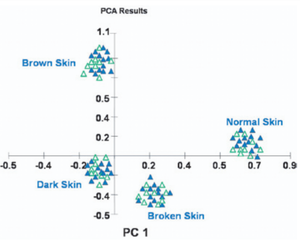Direct Analysis of Living Objects by Extractive Electrospray Ionization Mass Spectrometry
H. Chen and R. Zenobi
Abstract: 50 tons of spoiled meat discovered in Bavaria – authorities need to screen hundreds of warehouses! Spinach contaminated with E. coli leaves 200 people sick in the USA – rapid screening needed for suspected food! Epidemic − thousands of patients need to be rapidly screened in emergencies… What do these and similar headlines have in common? They all challenge modern analytical science in terms of sensitivity, specificity, speed, and especially throughput. It appears that extractive electrospray ionization mass spectrometry (EESI) provides a viable solution to these and other challenges.
EESI is a variant of electrospray ionization (ESI). In ESI, the sample is present in solution and is nebulized and ionized under the influence of high voltage and with the aid of a desolvation gas. Mass analysis is performed with a mass spectrometer having an atmospheric pressure ionization inlet; many different instruments for this purpose are available commercially. In EESI, the ion formation is turned ‘upside down’: a pure solution – usually water, which is sometimes acidified – is sprayed, and the sample, in the form of a gas, an aerosol, a volatilized liquid, or material desorbed from a solid, enters the charged mist through the desolvation gas line. The sample molecules get efficiently ionized by charge transfer processes and can be analyzed in a standard fashion.
The power of EESI has been demonstrated in a number of practical applications: i) The rapid in vivo fingerprinting of breath without sample pre-treatment. Metabolic dynamics was promptly reflected in the EESI data. ii) Non-invasive investigation of the maturity of fruit with high sensitivity, specificity, and high throughput. EESI fingerprinting of compounds released from various fruits yielded information on their ripening stages; the data were successfully differentiated by principal component analysis. iii) Direct, on-line analysis of biological matter such as skin, meat (even in the frozen state), and vegetables by directing a jet of N2 gas onto the sample followed by EESI-MS of the compounds liberated.
Currently, unsolved questions concern the nature of the charging mechanism, whether nonvolatile compounds can indeed be sampled and analyzed, and the identity of many of the signals showing up in the mass spectra (to be investigated by tandem-MS). This novel analytical strategy represents a ‘green’ procedure for fast chemical characterization of virtually any biological object. It will have many applications in areas such as metabolic fingerprinting, homeland security, food safety and medical diagnosis.


